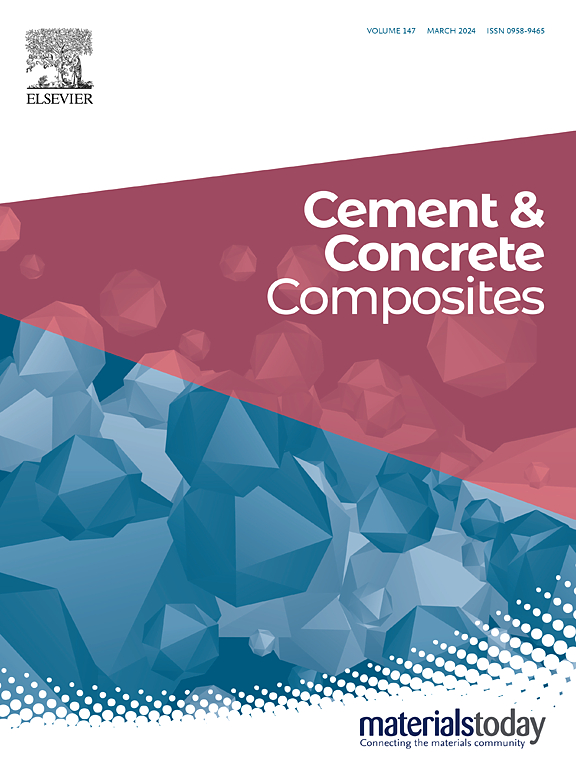Development of reactive carbonate-calcined clay-cement (C4) composites through synchronizing aluminate-carbonate reaction: Toward high compressive strength and low carbon emission
IF 10.8
1区 工程技术
Q1 CONSTRUCTION & BUILDING TECHNOLOGY
引用次数: 0
Abstract
Limestone calcined clay cement (LC3) offers a promising strategy for producing cement with significantly reduced CO2 emissions. However, it generally exhibits limited early-age compressive strength due to the uncoordinated reaction between limestone and aluminates, which is a consequence of the low reactivity of limestone. Moreover, further reducing the CO2 emissions of LC3 is a challenges. This study presents an innovative method for producing carbon-fixing calcium carbonates (Cc) with varied reactivities and highly reactive Si-Al gels via the mechano-carbonation of recycled concrete fines (CRCF), aimed at replacing limestone in LC3 production. This approach seeks to develop a high compressive strength and low-carbon cement composite, designated as Reactive Carbonate-Calcined Clay-Cement (C4). The results demonstrate that C4 shows a sustained improvement in compressive strength, with increases of over 30 % and 17 % at 1 d and 28 d, respectively, compared to the LC3. The superior early-age performance of C4 is attributed to a pivotal "reaction window" between the highly reactive Cc and Si-Al gels, which facilitates the generation of monocarbonate (Mc) due to the synchronized aluminate-carbonate reaction. The early precipitated Mc and calcium-silicate-hydrate (C-S-H) gels from the pozzolanic reaction of Si-Al gels serve as seedings, facilitating a higher cement reaction degree and the early strength development. Moreover, the moderately reactive Cc in CRCF still exhibits higher reactivity than limestone, enabling a more synchronized reaction with calcined clay at the later stages. This contributes to the formation of a more compact microstructure, thereby favoring the continued strength development. Moreover, C4 offers an additional advantage of reducing CO2 emissions by over 50 % in comparison to LC3, thus contributing significantly to environmental sustainability.
通过铝酸盐-碳酸盐同步反应制备活性碳酸盐-煅烧粘土-水泥(C4)复合材料:迈向高抗压强度和低碳排放
石灰石煅烧粘土水泥(LC3)是一种很有前途的生产水泥的方法,可以显著减少二氧化碳的排放。然而,由于石灰石与铝酸盐之间的不协调反应,通常表现出有限的早期抗压强度,这是石灰石低反应性的结果。此外,进一步减少LC3的CO2排放是一个挑战。本研究提出了一种创新的方法,通过再生混凝土细粒(CRCF)的机械碳化,生产具有不同反应活性和高活性硅铝凝胶的固碳碳酸钙(Cc),旨在取代LC3生产中的石灰石。该方法旨在开发一种高抗压强度和低碳的水泥复合材料,称为活性碳酸盐-煅烧粘土-水泥(C4)。结果表明,与LC3相比,C4的抗压强度持续提高,在第1天和第28天分别增加了30%和17%以上。C4优异的早期性能归因于高活性的Cc和Si-Al凝胶之间的关键“反应窗口”,该窗口促进了铝酸盐-碳酸盐同步反应生成单碳酸盐(Mc)。硅铝凝胶在火山灰反应中早期析出的Mc和水合硅酸钙(C-S-H)凝胶作为种子,促进了较高的水泥反应度和早期强度的发展。此外,中度反应的Cc在CRCF中仍然表现出比石灰石更高的反应活性,使得在后期与煅烧粘土的反应更加同步。这有助于形成更致密的微观结构,从而有利于强度的持续发展。此外,与LC3相比,C4具有减少二氧化碳排放50%以上的额外优势,因此对环境可持续性做出了重大贡献。
本文章由计算机程序翻译,如有差异,请以英文原文为准。
求助全文
约1分钟内获得全文
求助全文
来源期刊

Cement & concrete composites
工程技术-材料科学:复合
CiteScore
18.70
自引率
11.40%
发文量
459
审稿时长
65 days
期刊介绍:
Cement & concrete composites focuses on advancements in cement-concrete composite technology and the production, use, and performance of cement-based construction materials. It covers a wide range of materials, including fiber-reinforced composites, polymer composites, ferrocement, and those incorporating special aggregates or waste materials. Major themes include microstructure, material properties, testing, durability, mechanics, modeling, design, fabrication, and practical applications. The journal welcomes papers on structural behavior, field studies, repair and maintenance, serviceability, and sustainability. It aims to enhance understanding, provide a platform for unconventional materials, promote low-cost energy-saving materials, and bridge the gap between materials science, engineering, and construction. Special issues on emerging topics are also published to encourage collaboration between materials scientists, engineers, designers, and fabricators.
 求助内容:
求助内容: 应助结果提醒方式:
应助结果提醒方式:


